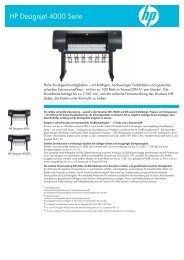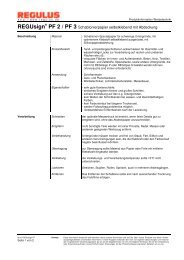STOCHASTIC HALFTONE SCREENING
STOCHASTIC HALFTONE SCREENING
STOCHASTIC HALFTONE SCREENING
Create successful ePaper yourself
Turn your PDF publications into a flip-book with our unique Google optimized e-Paper software.
C G T T E C H N I C A L P U B L I C A T I O N S<br />
This is especially important for reproduction<br />
of very light beiges and greys.<br />
Depending on how fine the dot is that<br />
you are printing, the exposure range will<br />
vary. For general purposes lower line<br />
counts (equivalent to 100 lpi and below), a<br />
latitude of 50%-100% is common. Above<br />
the equivalent of 100 lpi an increased<br />
range of 25%-50% is easily attainable.<br />
Depending on the color of your mesh,<br />
color of emulsion, light source, light<br />
intensity, and vacuum efficiency, increased<br />
latitude in excess of these generalized<br />
ranges is possible.<br />
Increased latitude is extremely important<br />
for large format (fleet graphics and outdoor<br />
advertising) because it helps to<br />
minimize the effect of edge-to-edge light<br />
fall-off on large frames. Because exposure<br />
uniformity is governed by the inverse<br />
square law, a wider latitude significantly<br />
improves side-to-side exposure of very<br />
large frames.<br />
Another key item with increased exposure<br />
range is that you can use the same<br />
exposure for a number of different meshes,<br />
thereby further eliminating more variables<br />
to the process color equation. While I<br />
admit that you may not be optimizing the<br />
exposure, as along as it is within the zone<br />
of process acceptability, eliminate as many<br />
of the other exposure choices as you can to<br />
keep it simple for your operators. For<br />
instance, if the screen maker knows that he<br />
has to use 75 units of exposure for FM<br />
halftones regardless of the mesh that he is<br />
using, you eliminate confusion and save<br />
time.<br />
Press characteristics<br />
On press the major difference that you<br />
will see is in dot gain. Next to moiré this is<br />
the most difficult item to control when<br />
printing halftones. What makes it such a<br />
problem is that with conventional halftones<br />
the dot changes size as tone in-<br />
creases. It reaches its greatest size at the<br />
50% dot, and begins decreasing in a<br />
negative version until it closes up. If we<br />
were to plot the rate of dot gain we would<br />
see that it follows the increase in dot size<br />
fairly closely. It peaks in the midtones, and<br />
declines as it approaches the solid coverage.<br />
The reason for this is that dot gain<br />
occurs around the perimeter of the dot. As<br />
the perimeter of the dot increases, so does<br />
the amount of available border that can<br />
experience dot gain.<br />
With stochastic halftoning, the rate of<br />
dot gain is different. Since all dots are the<br />
same size, the rate of dot gain is more or<br />
less constant. This is true as long as the<br />
total borderline of the covered tonal area is<br />
equal to the borderline of the conventional<br />
dot. For instance, if the border of a<br />
conventional dot is 300 microns, the dot<br />
gain will be similar as long as the total<br />
borderline of the smaller FM dots making<br />
up that tonal area does not exceed 300<br />
microns. Calculations for border dot gain<br />
should be left up to the separator to create<br />
the optimum dot for your printing application.<br />
Dot gain for textile will be significantly<br />
different than for vinyl or fine art<br />
paper.<br />
Aside from the prospect of more controllable<br />
dot gain, there is another great<br />
significance. There is no midtone jump.<br />
The typical problem of magenta fleshtones<br />
with conventional halftones is a thing of<br />
the past. Critical color reproduction of<br />
reference color and memory color is much<br />
easier to print and maintain over long<br />
runs.<br />
More controllable gain also means that<br />
it will be much easier to maintain neutral<br />
greys and beiges. It has been extremely<br />
difficult to achieve very light beiges and<br />
greys with halftone frequencies above 100<br />
lines. In the highlight areas a neutral grey<br />
is typically made up of a ratio of yellow,<br />
magenta, and cyan of 6:6:9. To obtain a<br />
TECH LIBRARY<br />
ONLINE<br />
TECHNICAL<br />
SUPPORT<br />
©1994 Coudray Graphic Technologies :: 805.541.1521 <strong>STOCHASTIC</strong> <strong>HALFTONE</strong> <strong>SCREENING</strong><br />
8
















